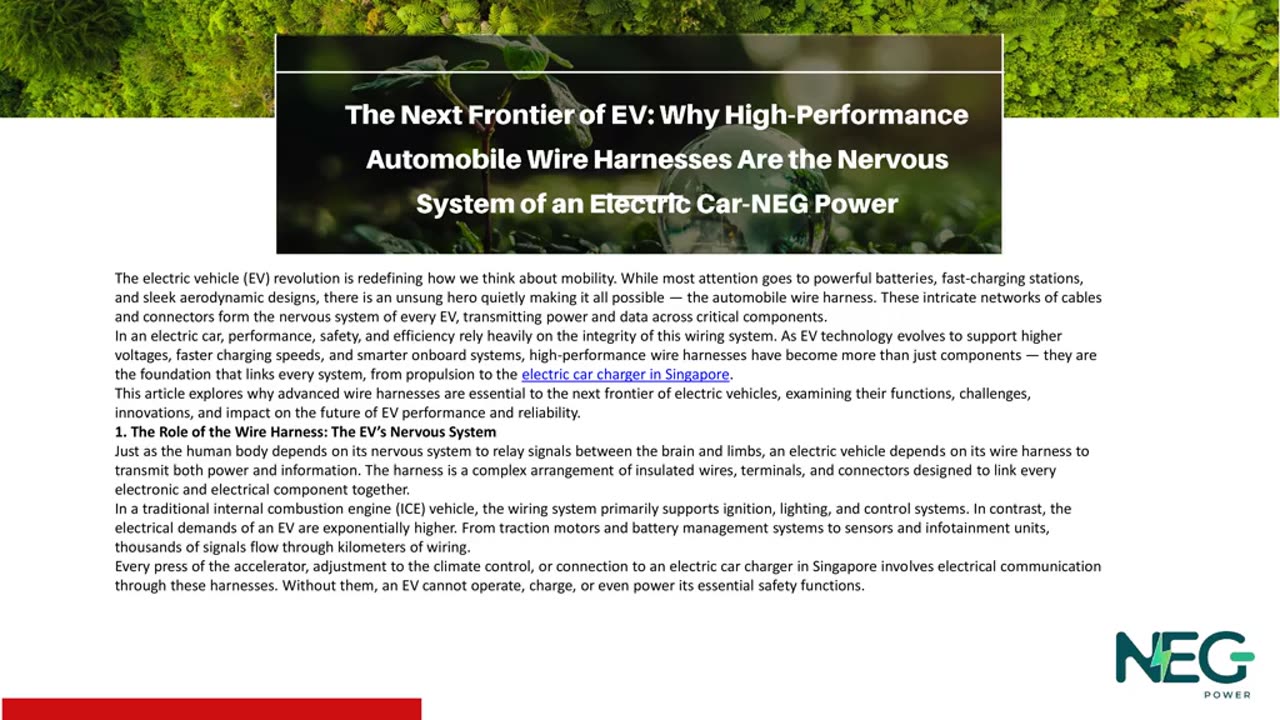Premium Only Content

The Next Frontier of EV: Why High-Performance Automobile Wire
The electric vehicle (EV) revolution is redefining how we think about mobility. While most attention goes to powerful batteries, fast-charging stations, and sleek aerodynamic designs, there is an unsung hero quietly making it all possible — the automobile wire harness. These intricate networks of cables and connectors form the nervous system of every EV, transmitting power and data across critical components.
In an electric car, performance, safety, and efficiency rely heavily on the integrity of this wiring system. As EV technology evolves to support higher voltages, faster charging speeds, and smarter onboard systems, high-performance wire harnesses have become more than just components — they are the foundation that links every system, from propulsion to the electric car charger in Singapore.
This article explores why advanced wire harnesses are essential to the next frontier of electric vehicles, examining their functions, challenges, innovations, and impact on the future of EV performance and reliability.
1. The Role of the Wire Harness: The EV’s Nervous System
Just as the human body depends on its nervous system to relay signals between the brain and limbs, an electric vehicle depends on its wire harness to transmit both power and information. The harness is a complex arrangement of insulated wires, terminals, and connectors designed to link every electronic and electrical component together.
In a traditional internal combustion engine (ICE) vehicle, the wiring system primarily supports ignition, lighting, and control systems. In contrast, the electrical demands of an EV are exponentially higher. From traction motors and battery management systems to sensors and infotainment units, thousands of signals flow through kilometers of wiring.
Every press of the accelerator, adjustment to the climate control, or connection to an electric car charger in Singapore involves electrical communication through these harnesses. Without them, an EV cannot operate, charge, or even power its essential safety functions.
2. Power Distribution: From Battery to Motion
At the heart of every electric vehicle is its high-voltage battery pack. However, the battery itself is only the power source — the wire harness is what delivers this energy efficiently and safely to the motor and auxiliary systems.
High-performance wire harnesses are responsible for managing both high-voltage and low-voltage circuits. The high-voltage wiring carries electricity from the battery to the inverter and motor, enabling motion. The low-voltage wiring powers control modules, lighting, sensors, and entertainment systems.
Because electric vehicles rely entirely on electrical energy, the wire harness must withstand intense electrical loads without overheating or degrading. To meet these challenges, manufacturers use specialized materials with high heat resistance, advanced insulation, and precise shielding to prevent electromagnetic interference.
A robust wire harness ensures that every kilowatt of power is transmitted cleanly and efficiently, maximizing performance while preserving the vehicle’s range.
3. Integration with Charging Systems
Charging is one of the most crucial functions of an electric vehicle, and it depends entirely on a reliable electrical connection. The wire harness plays a pivotal role in managing this connection between the vehicle and the electric car charger.
When a driver plugs in their EV, the harness facilitates communication between the vehicle’s battery management system and the charger. This communication ensures that the correct current and voltage levels are used, protecting the battery from overcharging or overheating.
Advanced wire harnesses are now designed to handle ultra-fast DC charging, where power levels can exceed hundreds of kilowatts. These harnesses must maintain exceptional conductivity while minimizing heat generation. Safety features such as temperature monitoring and automatic disconnection in the event of faults are integrated into the harness system to protect both the car and the user.
Without a reliable, high-quality wire harness, even the most advanced electric car charger in Singapore cannot deliver efficient power transfer. The harness ensures seamless charging sessions, consistent power flow, and long-term battery health.
4. Data Transmission and Smart Communication
Modern electric vehicles are data-driven machines. Every system — from battery monitoring to driver assistance — depends on constant data flow. The wire harness not only delivers power but also transmits data between sensors, control units, and onboard computers.
For instance, the vehicle’s energy management system uses data transmitted through the harness to optimize power distribution, monitor temperature, and regulate battery charging rates. Likewise, systems that control regenerative braking, speed regulation, and driver assistance rely on rapid and accurate communication through these wires.
To manage this growing complexity, EV wire harnesses integrate high-speed data cables similar to those used in aerospace applications. These cables are shielded to prevent signal loss or interference, ensuring that real-time data reaches its destination without delay.
This seamless communication network is what allows EVs to perform complex operations safely — coordinating acceleration, energy recovery, and even connectivity with external systems such as the electric car charger or mobile applications.
5. Safety: Protecting High-Voltage Systems
Safety is paramount in any electric vehicle. Since EVs operate at high voltages — often between 400 and 800 volts — the wire harness must be engineered to prevent electrical hazards such as short circuits, arcing, or fire.
Insulation materials are selected to resist extreme temperatures and chemical exposure. Protective sheaths and conduits guard against abrasion and environmental factors like moisture and vibration. The harness design also includes secure grounding systems to prevent electrical leakage.
In the event of an accident, intelligent disconnect systems isolate the battery and deactivate high-voltage circuits instantly, reducing the risk of electric shock. These systems rely on the precision and reliability of the wire harness to function correctly.
When integrated properly, the harness becomes an active safety component — guarding against failure and ensuring that the vehicle’s high-voltage architecture remains secure under all conditions.
6. Light weighting and Efficiency
Every gram counts in EV design. Reducing weight improves efficiency and extends driving range. Traditional wiring systems can be bulky, adding unnecessary mass. Engineers now focus on developing lightweight harnesses using advanced materials such as aluminum conductors, thinner insulation, and optimized routing paths.
High-performance harnesses are designed to deliver maximum current capacity with minimal material usage. Innovative manufacturing techniques, such as laser welding and automated crimping, enhance durability while keeping the harness compact and flexible.
The result is a lighter, more efficient electrical system that contributes directly to the vehicle’s performance and energy economy. Even the connection to the electric car charger in Singapore benefits from this optimization, as reduced electrical resistance improves charging efficiency.
7. Thermal Management and Durability
Electric vehicles generate heat during operation and charging. Excess heat can degrade components and reduce performance if not properly managed. The wire harness must therefore be designed with thermal resilience in mind.
High-performance harnesses incorporate materials capable of withstanding temperatures above 150°C, particularly in areas near power electronics and motors. They are also routed strategically to minimize exposure to heat sources while maintaining efficient energy flow.
Durability is equally crucial. The harness must endure thousands of hours of vibration, mechanical stress, and temperature fluctuation. To ensure reliability, manufacturers perform rigorous testing, including bending, twisting, and corrosion resistance assessments.
This combination of heat management and durability ensures that the EV operates safely and efficiently throughout its lifetime.
8. The Role of Innovation and Automation in Harness Production
As EV demand surges, producing wire harnesses efficiently and accurately becomes a critical challenge. Traditional manual assembly methods cannot meet the scale or precision required. Automation is transforming how wire harnesses are designed and manufactured.
Computer-aided design (CAD) tools map out complex wiring systems to optimize space, minimize interference, and simplify maintenance. Robotics and automated assembly lines ensure precise cutting, crimping, and bundling of wires, reducing human error.
Furthermore, advanced diagnostic systems can monitor harness integrity in real time, alerting technicians to potential failures before they cause issues. This predictive maintenance capability enhances safety and reliability, both during manufacturing and throughout vehicle operation.
9. Sustainability and Recyclability
Sustainability is a cornerstone of the EV movement, and that extends to the materials used in wire harnesses. Manufacturers are increasingly adopting recyclable plastics, halogen-free insulation, and environmentally friendly production processes.
Lightweight harnesses not only improve efficiency but also reduce the vehicle’s overall carbon footprint. Additionally, modular harness designs simplify disassembly, allowing valuable materials like copper and aluminum to be recovered during recycling.
As charging networks expand and more electric car charger installations emerge worldwide, sustainable manufacturing practices for components like wire harnesses ensure that the entire EV ecosystem aligns with green goals.
10. Looking Ahead: The Future of EV Wiring Systems
The evolution of electric vehicles will bring even greater demands on wiring systems. As vehicles adopt higher-voltage architectures (up to 1000V) and ultra-fast charging, wire harnesses will need to handle more power with less resistance.
Emerging technologies such as solid-state batteries, autonomous driving, and vehicle-to-grid (V2G) systems will further increase data and power requirements. The next generation of harnesses will incorporate smart sensors capable of self-diagnosis and adaptive routing to enhance safety and efficiency.
Integration with wireless data transfer systems, flexible printed circuits, and advanced insulation technologies will mark the next frontier of development — making EV wire harnesses smarter, lighter, and more efficient than ever.
Conclusion: The Unseen Backbone of Electric Mobility
Behind every silent, powerful, and efficient electric vehicle lies a complex network of wire harnesses that make it all possible. These systems are the invisible foundation connecting energy, communication, and control — the true nervous system of the EV.
From managing high-voltage power to coordinating with the EV charger in Singapore, high-performance wire harnesses ensure safety, reliability, and precision at every level. As the industry advances toward faster charging, smarter systems, and sustainable manufacturing, the wire harness remains central to innovation.
In the next era of electric mobility, those who master the science of wiring will shape the performance, safety, and sustainability of every electric car on the road.
Visists us : https://www.negpower.sg/
-
 1:08:32
1:08:32
DeVory Darkins
4 hours agoBREAKING: Minnesota Judge Makes FATAL MISTAKE Overturning Jury’s $7.2M Somali Fraud Verdict
104K83 -
 7:40
7:40
Colion Noir
1 hour agoArmed 7-Eleven Clerk Shoots Attacker & Gets Fired
6.26K30 -
 2:07:24
2:07:24
Side Scrollers Podcast
5 hours agoAsmongold/DSP RESPONSE + Kaceytron’s Life IMPLODES + Lunduke Gets Threats + More | Side Scrollers
94.4K6 -
 2:22:52
2:22:52
Steven Crowder
7 hours agoDonald Vs. Ilhan: Trump Boots Somalis and The Meltdown is Glorious
463K356 -
 1:04:37
1:04:37
Sean Unpaved
5 hours agoIs Lane Kiffin Staying At Ole Miss Or LEAVING For LSU? | UNPAVED
19.5K1 -
 29:48
29:48
The White House
5 hours agoPresident Trump and The First Lady Participate in the Thanksgiving Turkey Pardoning
37.4K26 -
 1:58:04
1:58:04
The Charlie Kirk Show
4 hours agoMark Kelly Court Martial + AI Embargo + Thanksgiving | Davis, Federer, Newcombe | 11.25.2025
74.7K23 -
 53:20
53:20
The Rubin Report
5 hours agoLara Trump Destroys Bill Maher’s Narrative w/ Facts in 1 Minute
54.5K65 -
 56:32
56:32
TheAlecLaceShow
4 hours agoGuest: Rep. Tim Burchett | Ukraine Russia Peace Deal | Trump SLAMS Seditious 6 | The Alec Lace Show
23.2K1 -
 LIVE
LIVE
LFA TV
18 hours agoLIVE & BREAKING NEWS! | TUESDAY 11/25/25
1,235 watching